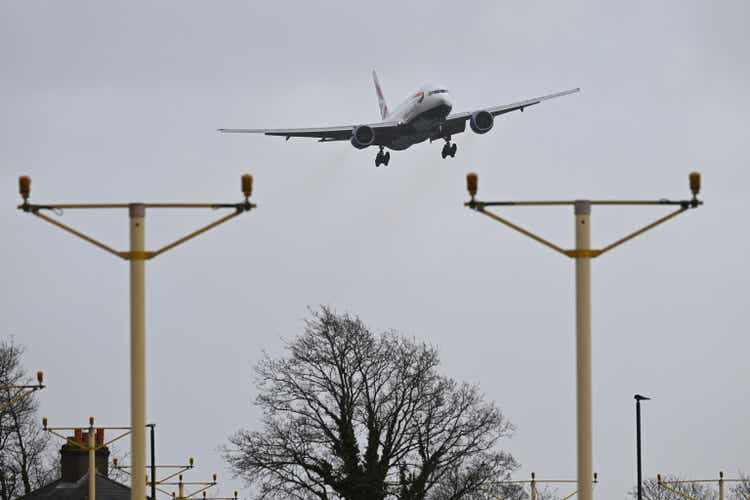Leon Neal
Boeing Manufacturing
737
The Boeing Company (NYSE:BA) commercial aircraft shipments are either constrained by a lack of manufacturing output or blocked by the FAA.
Manufacturing of the 737 is limited by the availability of engines. The engines are limited because GE can’t get enough castings to produce the engines. Boeing wants to move production up to 38 units a month from the current 31. They won’t do that until they’re convinced that GE can supply the engines.
Boeing is becoming more disciplined to manufacture only when they have the parts rather than having to go back and modify the aircraft. This approach increases quality and lowers costs in the long run.
Boeing’s inventory of 737s totals 290 units. Boeing is slow in converting its inventory to shippable aircraft. In the second quarter, they shipped only 10 inventoried 737s aircraft. They need to drastically speed up this process, but it takes more labor to upgrade inventory units than to assemble new units.
787
Boeing has 120 787s in inventory. It is not clear how long it will take or how much it will cost to modify these units.
Boeing anticipates that the FAA will finally authorize shipments of the 787. They said the same thing last year and that this has been an incredible torturous process. However, they are convinced from their discussions that at an unknown date in the third quarter shipments will begin. These shipments are critical to returning the company to stable profitability. Even with the beginning of shipments, there will still be roughly $2 billion of abnormal production costs before the program returns to normality. The 787 is a highly profitable program and it will be strongly profitable in the future.
FAA certification
Abnormal production costs because of low volume or rework on 787 and 777X in Q2 were $392 million. The government hired MITER corporation to review the inspection process. They concluded that no aircraft is risk-free when it takes to the air. They also concluded that FAA process is far too excessive and adherence to detailed procedures does not add to safety. So, they would recommend a much more streamlined approach. However, it’s unlikely to happen at least not with the current administration.
Narrow body market
Boeing released the market potential for commercial aircraft over the next 10 years. The total addressable market is $3.3 trillion. Boeing has a strong offering in the wide-body market but lags behind Airbus (OTCPK:EADSF) in the narrow-body market. Boeing forecasts there is a demand for 120 narrowbodies per month. Boeing stated that it will continue work on the Max 7 and the Max 10 and it expects to have these certified by year-end. That is a change from their previous position that they would go to Congress and have the bill altered so that the program could continue passed the year-end limit per certification. Both aircraft have large backlogs even though certification is uncertain.
Boeing has also begun to discuss with customers the next generation of aircraft to fit in the narrowbody market in competition with the 321XLR. David Calhoun had previously said they would be launching the program without a greatly improved engine. Now Pratt and Whitney have announced plans for a new generation geared turbofan with a 10% performance improvement by the end of the decade. This would make Airbus’s narrow-bodied aircraft less competitive. Airbus had been talking about coming up with a new narrow-body line in the late 30s. The Boeing approach would combine manufacturing and engineering models and shorten the program from a 10-year program to a 5-year program.
777X
The 777X is now scheduled for shipment in 2025. This significant delay from the original timeline is, in part, due to the FAA’s demand to meeting the EASA regulations. The program could benefit from a growing market for intercontinental transport. The 777-8 freighter has been introduced and is planned for introduction in 2027. In addition, there is a demand from some airlines for larger than 777-9 aircraft. The dash 9 can be easily expanded because the engine turned out to be larger than needed for the aircraft.
Conclusions
Boeing has committed to increasing cash flow so that it is generated positive free cash flow in 2022. It also expects to generate higher unit profitability in 2023. They expect higher volume and a stable manufacturing environment to increase margins.
Boeing has been reluctant to provide a detailed plan for the future because of all the problems with government regulation and supply chain issues. In November, they plan to quantify their outlook for the future. This will provide much more certainty about the long-term outcomes. Boeing’s objective has been to have manufacturing stability and to meet manufacturing schedules. The stability also encourages cost reductions which will provide detailed financials. In 2025, with the first of the 777X, it will have higher revenue.
It will take time to recover, but the year-over-year profit growth should be substantial. Boeing is a buy.


Be the first to comment